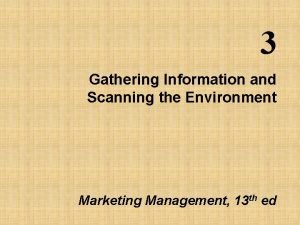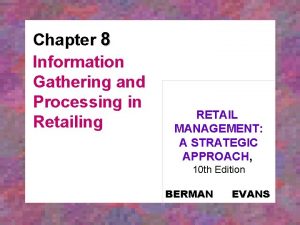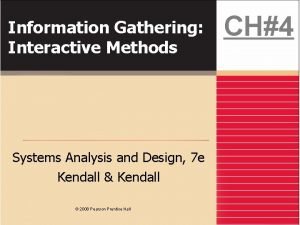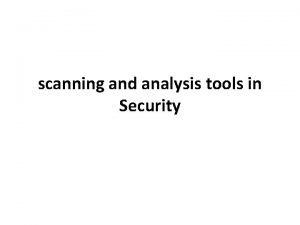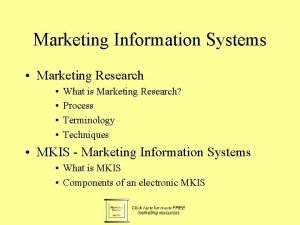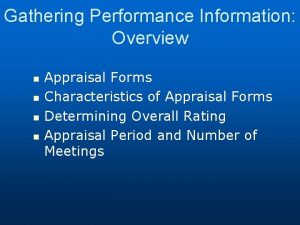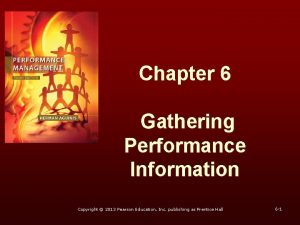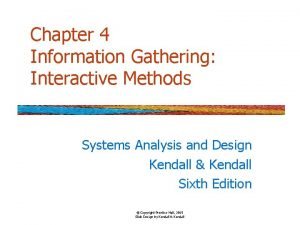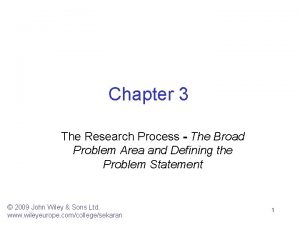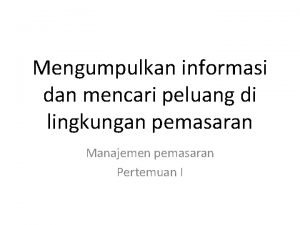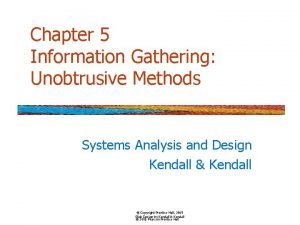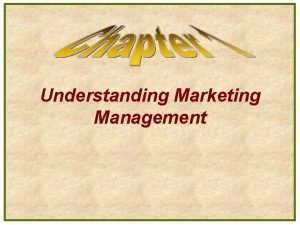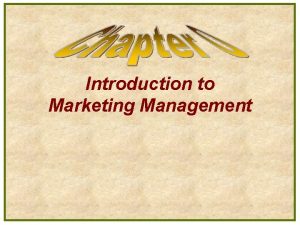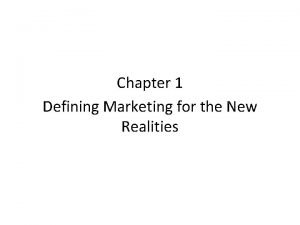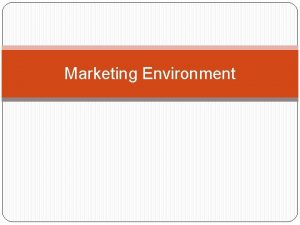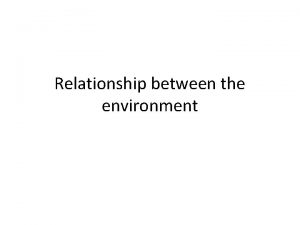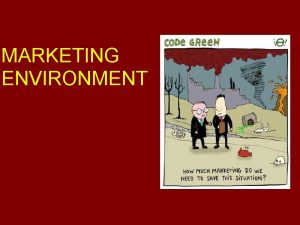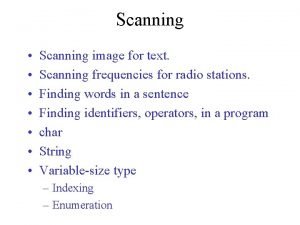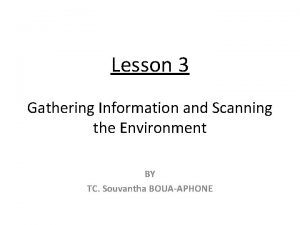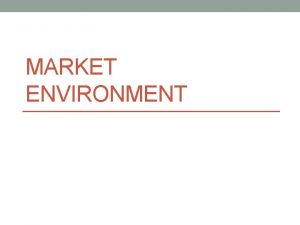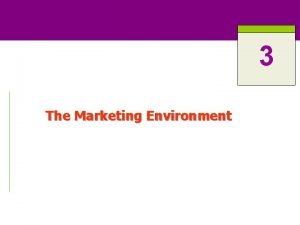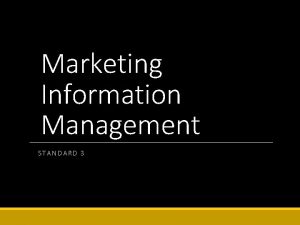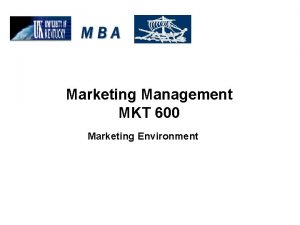MARKETING MANAGEMENT Gathering Information and Scanning the Environment





































- Slides: 37

MARKETING MANAGEMENT Gathering Information and Scanning the Environment

Chapter Questions What are the components of a modern marketing information system? What are useful internal records? What is involved in a marketing intelligence system? 3 -2

Chapter Questions What are the key methods for tracking and identifying opportunities in the macroenvironment? What are some important macroenvironment developments? 3 -3

MIS Probes for Information What decisions do you regularly make? information do you need to make these decisions? What information do you regularly get? What special studies do you periodically request? What information would you want that you are not getting now? What are the four most helpful improvements that could be made in the present marketing information system? 3 -4

marketing information system MIS: consists of people, equipment, and procedures to gather, sort, analyze, evaluate, and distribute needed, timely, and accurate information to marketing decision makers. 3 -5

Internal Records Order-to-Payment Cycle Sales Information System Databases, Warehousing, Data mining Marketing Intelligence System 3 -6

Steps to Improve Marketing Intelligence Train and motivate sales force Motivate channel members to share intelligence Network externally Utilize customer advisory panel Utilize government data resources Purchase information Collect customer feedback online 3 -7

Needs and Trends Fad Trend Megatrend 3 -8

10 Megatrends Shaping the Consumer Landscape Aging population Delayed retirement Changing nature of work Greater educational attainment Labor shortages Increased immigration Shifting birth trends 3 -9

Environmental Forces Demographic Economic Socio-Cultural Natural Technological Political-Legal 310

Population and Demographics Size Household Growth patterns Regional characteristics Movement rate Age distribution Ethnic mix Educational levels 311

Economic Environment $ Purchasing Power $ Income Distribution $ Savings Rate $ Debt $ Credit Availability 312

Types of Industrial Structures Industrial economies Industrializing economies Raw-material exporting economies Subsistence economies 313

Social-Cultural Environment Views of themselves Views of others Views of organizations Views of society Views of nature Views of the universe 314

Natural Environment Shortage of raw materials Increased energy costs Anti-pollution pressures Governmental protections 315

Technological Environment Pace of change Opportunities for innovation Varying R&D budgets Increased regulation of change 316

Identifying Market Segments and Targets Kotler Keller

Chapter Questions What are the different levels of market segmentation? How can a company divide a market into segments? How should a company choose the most attractive target markets? What are the requirements for effective segmentation? 818

Effective Targeting Requires… Identify and profile distinct groups of buyers who differ in their needs and preferences. Select one or more market segments to enter. Establish and communicate the distinctive benefits of the market offering. 819

Ford’s Model T Followed a Mass Market Approach 820

Four Levels of Micromarketing Segment marketing Niche marketing Local marketing Customerization 821

Segment Marketing Targeting a group of customers who share a similar set of needs and wants. 822

Flexible Marketing Offerings Naked solution ◦ Product and service elements that all segment members value Discretionary options ◦ Some segment members value ◦ Options may carry additional charges 823

Customerization Combines operationally driven mass customization with customized marketing in a way that empowers consumers to design the product and service offering of their choice. 824

Basic Market-Preference Patterns 825

Segmenting Consumer Markets Geographic Demographic Psychographic Behavioural © Copyright 2008 Pearson Education Canada 7 -26

Segmenting Consumer Markets Bases for Segmentation Geographic Demographic Nation or country Province or region City or metro size Density Climate Psychographic Behavioural © Copyright 2008 Pearson Education Canada 7 -27

Segmenting Consumer Markets Bases for Segmentation Geographic Demographic Psychographic Behavioural Age, race, gender Income, education Family size Family life cycle Occupation Religion, nationality Generation Social class Example: RBC Financial created a “gender intelligent sales force” that led to a 29% increase in customer satisfaction in women entrepreneurs © Copyright 2008 Pearson Education Canada 7 -28

Segmenting Consumer Markets Bases for Segmentation Geographic Demographic Psychographic Lifestyle ◦ Activities ◦ Interests ◦ Opinions Personality Behavioural © Copyright 2008 Pearson Education Canada 7 -29

Segmenting Consumer Markets Bases for Segmentation Geographic Demographic Psychographic Behavioral Occasions Benefits User status Usage rate Loyalty status Attitude ◦ Enthusiastic, positive, indifference, negative and hostile. © Copyright 2008 Pearson Education Canada 7 -30

Behavioural Segmentation: Decision Roles Initiator Influencer Decider Buyer User © Copyright 2008 Pearson Education Canada 7 -31

Behavioral Segmentation Variables Occasions Attitude Benefits Variables User status Loyalty Buyerreadiness Usage rate © Copyright 2008 Pearson Education Canada 7 -32

Loyalty Status Hard-core Split loyals Shifting loyals Switchers © Copyright 2008 Pearson Education Canada 7 -33

Major Segmentation Variables for Business Markets Demographic Operating variable Purchasing approaches Situational factors Personal characteristics © Copyright 2008 Pearson Education Canada 7 -34

Sequential Segmentation and Stage of Purchase Process First-time prospects Novices Sophisticates © Copyright 2008 Pearson Education Canada 7 -35

Steps in Segmentation Process Needs-based segmentation Segment identification Segment attractiveness Marketing-mix strategy Segment profitability Segment positioning Segment acid test © Copyright 2008 Pearson Education Canada 7 -36

Effective Segmentation Criteria Measurable Actionable Substantial Accessible Differentiable © Copyright 2008 Pearson Education Canada 7 -37
 Gathering information and scanning the environment
Gathering information and scanning the environment Gathering information and scanning the environment
Gathering information and scanning the environment Gathering information and scanning the environment
Gathering information and scanning the environment Gathering information and scanning the environment
Gathering information and scanning the environment Scanning the marketing environment
Scanning the marketing environment Techniques of environmental scanning
Techniques of environmental scanning Information gathering and processing in retailing
Information gathering and processing in retailing Gathering information and measuring market demand
Gathering information and measuring market demand Measuring market demand
Measuring market demand Information gathering interactive methods
Information gathering interactive methods Identification of scanning and analysis tools
Identification of scanning and analysis tools Finer segmentation strategy
Finer segmentation strategy Marketing information systems and marketing research
Marketing information systems and marketing research Marketing information systems and marketing research
Marketing information systems and marketing research Marketing information systems and marketing research
Marketing information systems and marketing research Marketing information system kotler
Marketing information system kotler Marketing information systems and marketing research
Marketing information systems and marketing research 9 major components of appraisal forms
9 major components of appraisal forms Gathering performance information
Gathering performance information Information gathering: interactive methods
Information gathering: interactive methods Identify a broad problem area examples
Identify a broad problem area examples 1 mencari atau mengumpulkan informasi
1 mencari atau mengumpulkan informasi Unobtrusive methods of information gathering
Unobtrusive methods of information gathering The action or activity of gathering information
The action or activity of gathering information Gathering background information
Gathering background information Gathering background
Gathering background Maltego information gathering
Maltego information gathering Environment of business finance
Environment of business finance Internal scanning in strategic management
Internal scanning in strategic management Internal scanning in strategic management
Internal scanning in strategic management Understanding marketing management
Understanding marketing management Marketing management objective
Marketing management objective Marketing management definition
Marketing management definition New marketing realities
New marketing realities Marketing environment definition
Marketing environment definition The marketing environment ethics and social responsibility
The marketing environment ethics and social responsibility Marketing environment micro and macro
Marketing environment micro and macro Define marketing information system
Define marketing information system


